Southern California is hot and dry and needs hardy plants to tolerate the heat. The perfect flowers to plant here are those native to southern California.
It would be best to have the right guide to choosing flowers that can thrive in these conditions. The riskiest locations in your garden are those parts with the full sun, so you need sun-proof flowers to beat the heat naturally.
Below we discuss a few flowers to grow in Southern California. These plants will bring back the bees and butterflies that were otherwise missing in your garden. Landscape your garden with these flowers to keep your garden vibrant and cheerful.
Miss Kim lilac
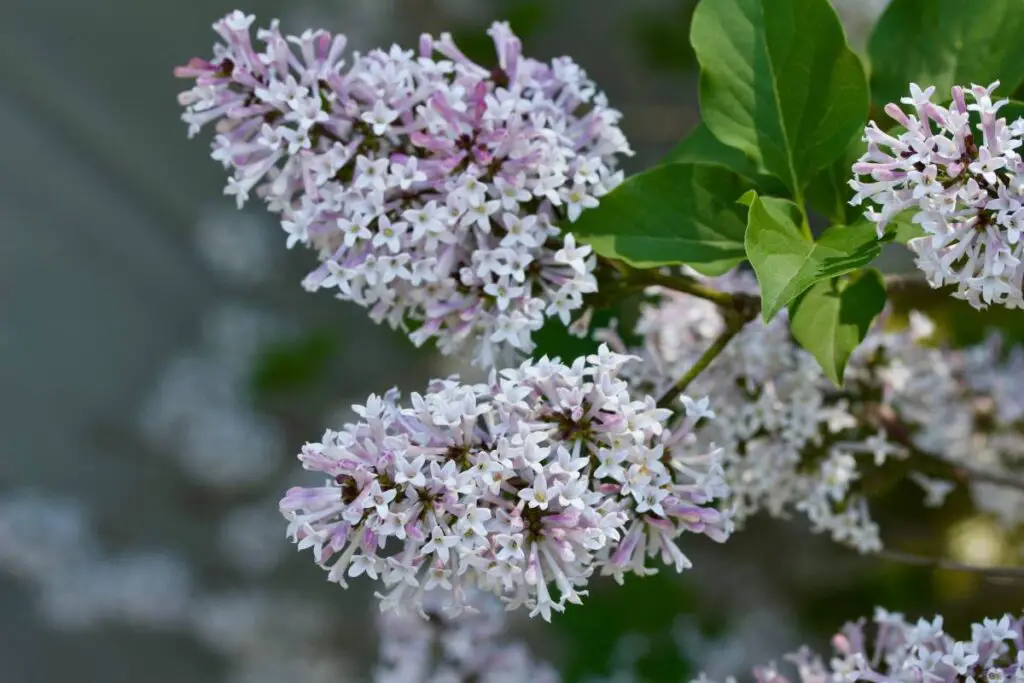
Miss Kim lilac is a compact hardy plant with clusters of aromatic purple small flowers. Its mature height is up to 8 feet, which is considered small compared to other lilacs. It is a slow-growing plant that can take up to 3 years to achieve its mature size. Miss Kim Lilac is a perfect choice to grow in Southern California. It is nectar-rich and comes in multiple colors that attract bees and butterflies.
Sunlight: When kept in full sun, Miss Kim lilac has the best growth and abundant blooms. Ideally, a location where miss Kim lilac can receive six to eight hours of the entire sum is perfect for the plant. If you wish to keep it in the shade or low light, you might have to compromise in flowering.
Watering: Water miss Kim lilac moderately to keep its soil moist and not soggy. Young plants require frequent watering to establish strong roots. Once the plant is well rooted, it can withstand dry spells. Water the plant according to the weather; watering is not required during rainfall. If the weather is dry and hot, consider weekly watering the plant. The idea is to neither underwater nor over-water the plant.
Fertilizer: Miss Kim lilac is a light feeder. Start by feeding it one month after planting it in the spring. After that, providing food in the early spring annually is enough. Use a diluted liquid-balanced fertilizer and look at the label for the amount you use.
General care: Miss Kim lilac prefers warm temperatures and tolerates cold temperatures below -10°F. It can grow well in humid conditions. Deadhead faded flowers to promote and prolong blooming.
California Poppy
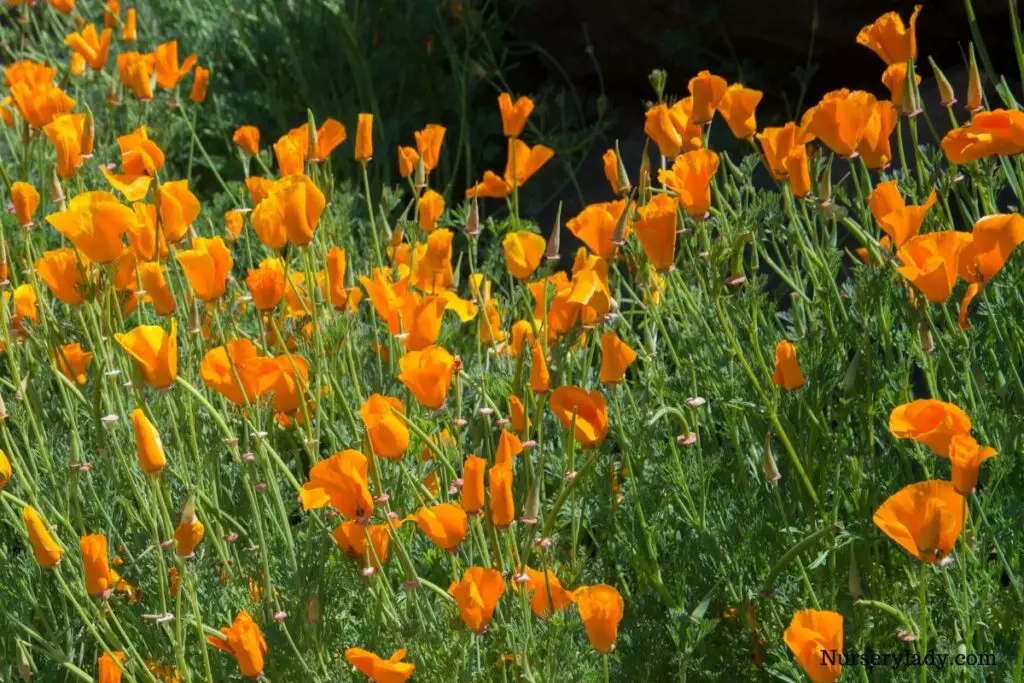
California poppy is an excellent choice for growing in Southern California. It develops quickly in Southern California’s conditions and self-seeds every year. Due to its self-seeding nature, it will pop up yearly without much hard work. It is excellent for covering large areas or growing in containers or pots.
Sunlight: California poppies grow best in full sun, i.e., at least 6 to 8 hours of direct sun daily. The brighter the spot, the happier the plant is. The plant may become leggy and easily prone to diseases in shady locations.
Watering: California poppies are drought tolerant, thus requiring significantly less water to thrive. During the hot summer, the plant may be dormant and will survive after this time.
Fertilizer: Feeding is not necessary for California poppies to flourish. They can even thrive and bloom in inferior soil. Chemical fertilizer will boost the plant’s foliage growth, jeopardizing the number of blooms.
General care: California poppies are used to the temperatures of Southern California. They prefer temperatures between 50°F to 75°F for healthy growth. Yes, they will go dormant during high-temperature levels but will come back and bloom once the temperature cools down. The plant likes low to average humidity levels. If there is high humidity, ensure good airflow and proper drainage to prevent the plant from any diseases.
Penstemon
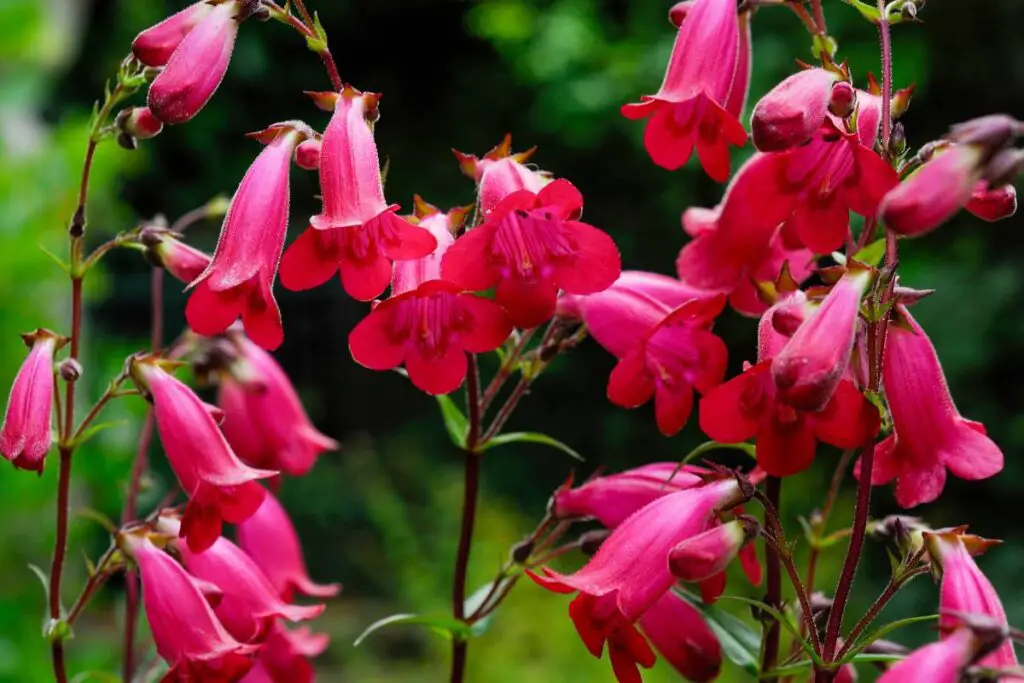
Penstemon is my favorite and is native to Southern California. Its beautiful tubular bloom adds a colorful vibe to your garden. Moreover, flowers attract bees and other pollinators around them. Penstemon will be a great choice to fill in the space between spring and summer. You can grow it from seeds in spring and wait for some time to let it germinate and then grow.
Sunlight: Penstemon grows best in full sun. Its tall stalks will droop in low light or shade. Providing 6-8 hours of direct sun is enough for the plant to stay healthy and have abundant blooms.
Watering: Penstemon is drought tolerant but will have better growth with weekly irrigation. Please give it a weekly drink during summer for vigorous growth and blooming.
Fertilizer: Penstemon can be fed with organic fertilizer annually during the fall. Too much fertilizer or using bloom-boosting fertilizer may promote growth but will curtail the plant’s life. You can also add mulch once during the growing season, and it will also control weeds.
General care: Penstemon prefers warm temperatures. It can withstand all humidity levels. Cut off the spent blooms up to the stem to promote flowering. Pruning is unnecessary except if you want to keep it in a particular shape.
Morning glory
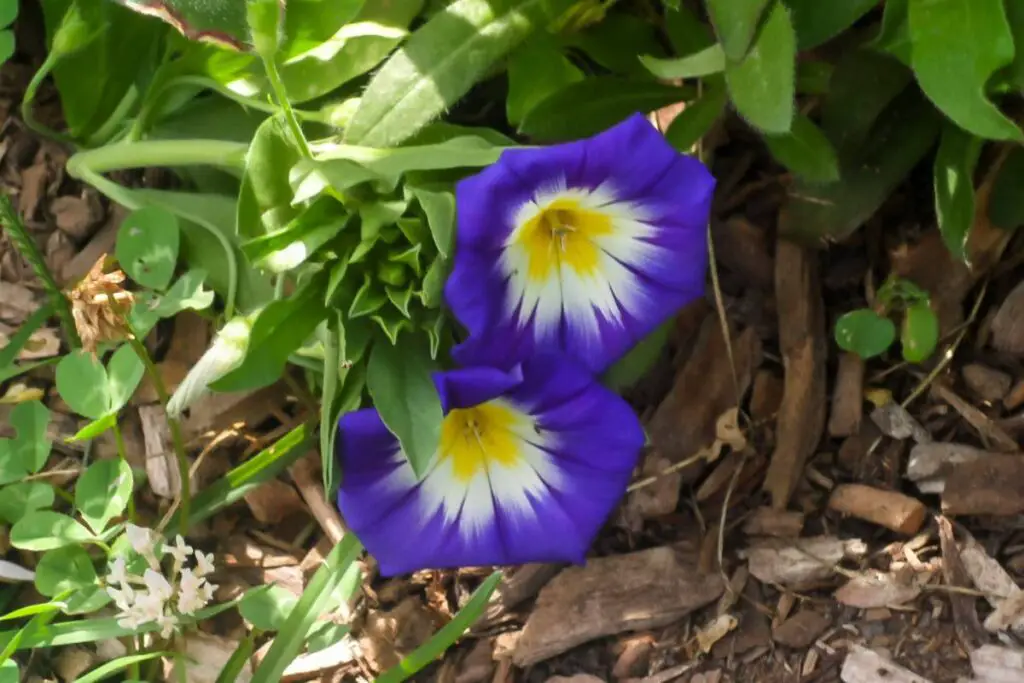
Morning glory features trumpet-shaped flowers with a subtle fragrance. It looks best when creating a boundary. It draws bees and butterflies in your garden. It can grow up to 12 feet in height during its growing period. It is low maintenance and self-sows, making it easier to have multiple plants. Also, use a trellis to support its vines or keep pruning.
Sunlight: Morning glory likes good lighting and demands 6-8 hours of daylight daily to fulfill its daily light dose. Its flower buds are upheld at night and open only when exposed to direct sun. If the plant doesn’t receive light until the afternoon, its bloom will not bloom.
Watering: Keep your morning glory well-watered to moisten the soil. It especially demands regular watering during its growing period. Mulching around the roots helps retain moisture. Always check the soil moisture before watering to avoid over-watering.
Fertilizer: Feed morning glory with balanced or low-nitrogen fertilizer once a month during its growing period. If the blooms are not as much as expected, feed the plant with a fertilizer high in phosphorus.
General care: Morning glory is hardy and tolerates cold and warm temperatures. It can even withstand the first frost and keep blooming. It can handle all humidity levels. Due to its robust nature, it cannot be easily bothered by pests, rot, blisters, etc.
Looking for gardening supplies? We have tested 100's of products before recommending them to you guys. Check out our best pick below:
| Image | Gardening Supplies | Best Price? |
|---|---|---|
 Top
Top Top
Top | Raised Garden Bed Kit | Check On Amazon |
 | XLUX Soil Moisture Meter, Plant Water Monitor, Soil Hygrometer Sensor for Gardening, Farming, Indoor and Outdoor Plants, No Batteries Required | No Results |
 Top
Top Top
Top | 82 Pcs Garden Tools Set and Extra Succulent Tools Set | Check On Amazon |
 | Joeys Garden Expandable Garden Hose with 8 Function Hose Nozzle, Lightweight Anti-Kink Flexible Garden Hoses, Extra Strength Fabric with Double Latex Core, (50 FT, Black) | No Results |
 Top
Top Top
Top | Dual Chamber Compost Tumbler | Check On Amazon |
 Top
Top Top
Top | Sunnyglade Plant Stakes | Check On Amazon |
 Top
Top Top
Top | Organic Cold Pressed Neem Seed Oil | Check On Amazon |
 Top
Top Top
Top | Mighty Mint Gallon :-Insect and Pest Control Peppermint Oil | Check On Amazon |
 Top
Top Top
Top | Scotts DiseaseEx Lawn Fungicide | Check On Amazon |
 Top
Top Top
Top | Jacks Classic 20-20-20 All Purpose Fertilizer | Check On Amazon |
 Top
Top Top
Top | 30,000 Seeds Pollinator Attracting Wildflower Mixture | Check On Amazon |
 Top
Top Top
Top | Survival Vegetable Seeds Garden Kit-Over 16,000 Seeds | Check On Amazon |
The Nippon daisy
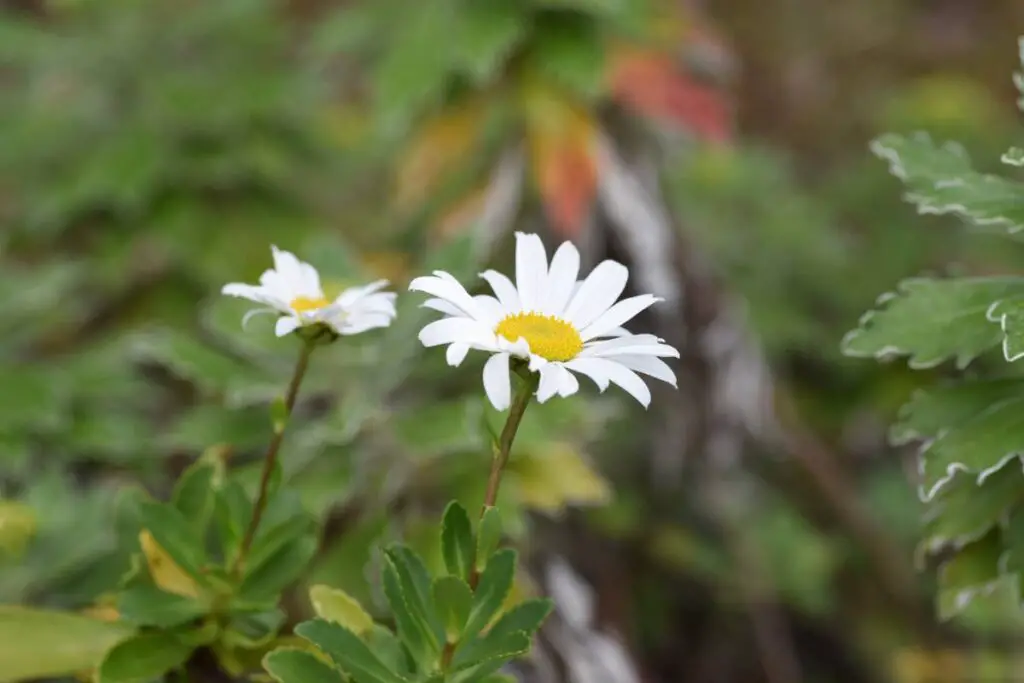
The Nippon daisy features leathery green leaves with white flowers growing on tall stalks. It even serves as a long-lasting cut flower. Being native to Southern California, it is a great and easy option to grow and care for. It grows at full speed and reaches its mature size in 2 months. It blooms from summer till frost with little care.
Sunlight: The Nippon daisy grows and blooms best in full sun. In hot summer, keeping the plant in partial shade is advised.
Watering: The Nippon daisy likes to be on the drier side. It can easily withstand drought and will not need any watering during rainfall. If your area is dry for an extended period, consider watering the plant.
Fertilizer: The Nippon daisy is a light feeder, or can say it doesn’t require feeding at all. However, if the plant is growing in inferior soil, it is suggested to apply balanced food in the early spring. Avoid too much feeding, as it can result in yellow leaves and limp stems.
General care: The Nippon daisy wishes for warm temperatures but away from high heat. Please keep them in a safe environment when there are frequent temperature fluctuations in your zone, as it can even kill the Nippon daisy. It can withstand all humidity levels. Trim the new growth during spring so that the plant grows upright. Remove spent flowers for prolonged blooming.
Dahlias
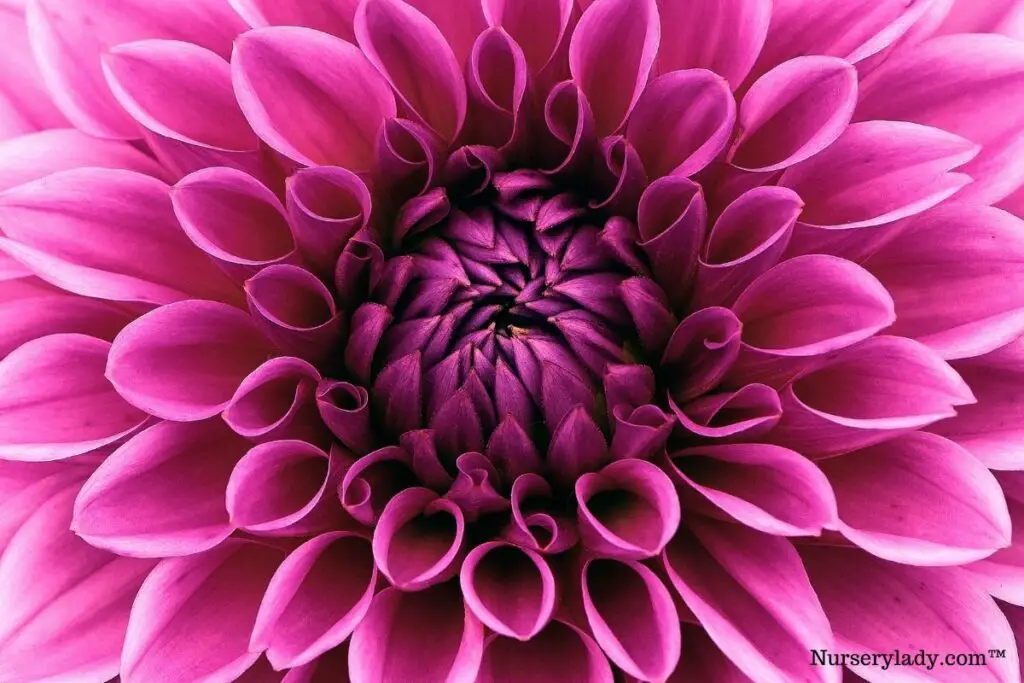
Dahlias are popular plants with various flowers in multiple color palettes, forms, shapes, etc. They are easy to grow as they are produced from tubers, which you can plant in the ground once the soil has warmed up after frost. You can find dahlia plants in your nearest nursery. Use stakes to keep the long flower stalks upright.
Sunlight: Dahlias will have abundant flowers in full sun, keeping the plant in the sun for at least 6 hours daily. In hot summer, some shade relieves the plant from the hot sun.
Watering: Dahlia tubers do not need water when planted until some growth shows above the soil. Once it starts growing, the root system develops, and the plant needs water. Water deeply in regular intervals to keep the soil evenly moist. During hot summer, ensure regular watering and avoid drying out of the soil.
Fertilizer: Dahlias being heavy feeders, can gulp all the food you give them. They tend to grow bigger with feeding. A fertilizer high in phosphorus is advised to encourage blooming. Follow the instructions on the product label to determine the correct dosage. If you want to dig up and conserve dahlia tubers for winter, hold feeding at the end of August to prepare the tubers for inactivity.
General care: Dahlias prefer warm temperatures and go dormant in winter. Keep them indoors during the cold and move them outdoors once the frost has passed. Also, if you store dahlia tubers for winter, ensure the area where you store them has little humidity to prevent the tuber from drying out.
Coleus
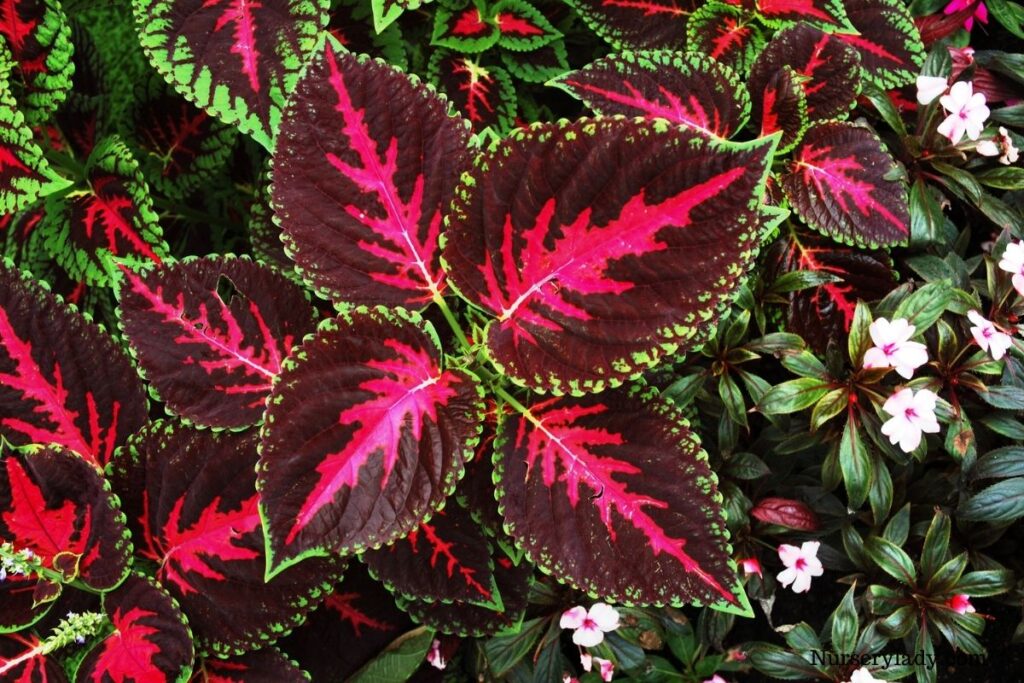
Coleus is a beautiful plant that will grow in just about any garden. It offers a variety of colorful foliage like green, red, pink, maroon, and purple in multiple shapes, styles, colors, patterns, etc. Their tiny flowers also add color to the plant and look ravishing as flower beds. It also slays in window boxes, containers, and hanging pots. It spreads quickly, filling the baldness or empty spots easily.
Sunlight: Coleus likes full-sun exposure and develops well in partial to full shade. Since light needs vary with variety, depending on the type you have, keep the plant in its desired lighting. Usually, too much direct sun during hot weather scorches their leaves. Keep the plant in indirect bright light daily in hot weather. During cold weather, it’s good for container plants to be exposed to some sunlight.
Watering: Coleus likes evenly moist soil but doesn’t like to stay soggy. Also, if you keep your plant dry for a long duration, the plant’s growth slows down. Water the plant when the soil is halfway dry and drain the excess. You can use a mulch to retain moisture, but don’t let it touch stems to avoid stem rot for coleus plants growing in containers, water frequently during summers.
Fertilizer: Coleus are tolerant plants, and those growing in rich soil will flourish without feeding. In poor soil, you can add slow-release food in their growing period.
General care: Coleus prefers hot and humid climates. It cannot bear frost and will die in frost. They need extra care and protection in chilly temperatures. Keep coleus plants away from cold drafts, air conditioners, vents, etc. Pinching the growing tops helps in fuller and bushier growth.
Cosmos
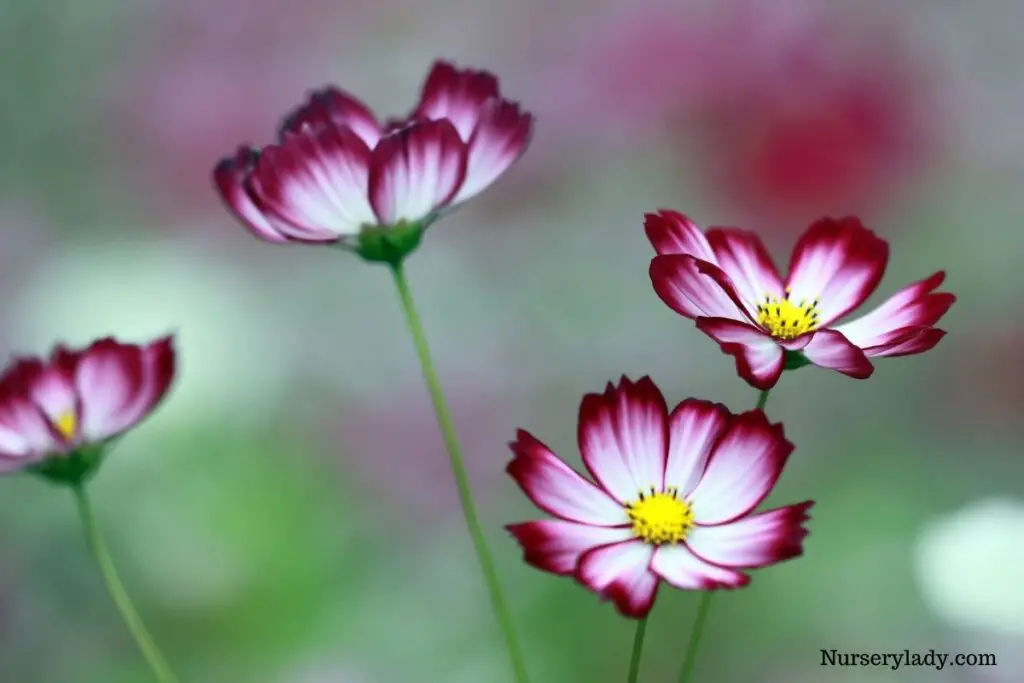
Cosmos are easy-to-maintain quintessential plants. They reach up to 6 feet in height with flowers on tall stalks. Their display game is on point due to their showy flowers in multiple colors attracting bees and butterflies. Though they are easy-going, low-maintenance plants, do not neglect them altogether, pushing them towards diseases. They look great as flower beds, in containers, and used as cut flowers.
Sunlight: Cosmos likes the sun and appreciates a full day of sun on most days. They will grow in partial shade, too but will have fewer blooms. They can even tolerate the sun in the hottest summers too.
Watering: Cosmos will never ask for a drink unless there is a prolonged drought period. They are the last plants in your garden to ask for water.
Fertilizer: Cosmos will have the best blooms even without any feeding. Too much feeding will only boost foliage growth, compromising the number of flowers. Apply a balanced fertilizer only if the plant seems to struggle.
General care: Cosmos thrives in hot temperatures and all humidity levels. Deadheading is crucial for the plant to extend its flowering duration. Also, keep them at a distance from each other to avoid diseases.
Zinnias
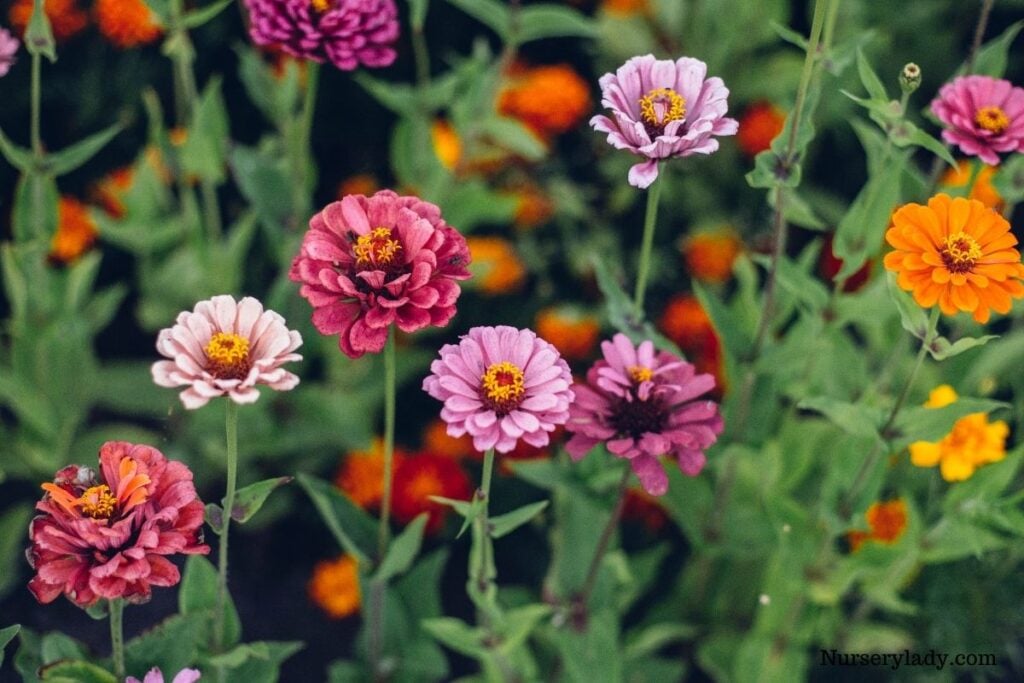
Zinnias are tolerant plants with pretty flowers in a variety of hues. It will never stop f, lowering, and the more you cut flowers, the more blooms they will have. They will grow in neglect, too, displaying their hot-palette flowers and rough leaves all summer. Zinnias are perennials due, so it is significant to plant their seeds if you want them to grow every year.
Sunlight: Zinnias need full sun for the best blooms and growth. If there is low light available, the plant may suffer due to powdery mildew, leaf spot, etc.
Watering: Zinnias would not ask for a drink unless there is a long dry spell. They can do without watering as they are highly drought tolerant.
Fertilizer: Zinnias don’t need food to grow and bloom. Though the correct dose of well-balanced fertilizer occasionally will be enough to give the plant a nutrient boost now and then.
General care: Zinnias like warm temperatures. They will keep blooming even in the hot temperatures of Southern California.
Marigolds
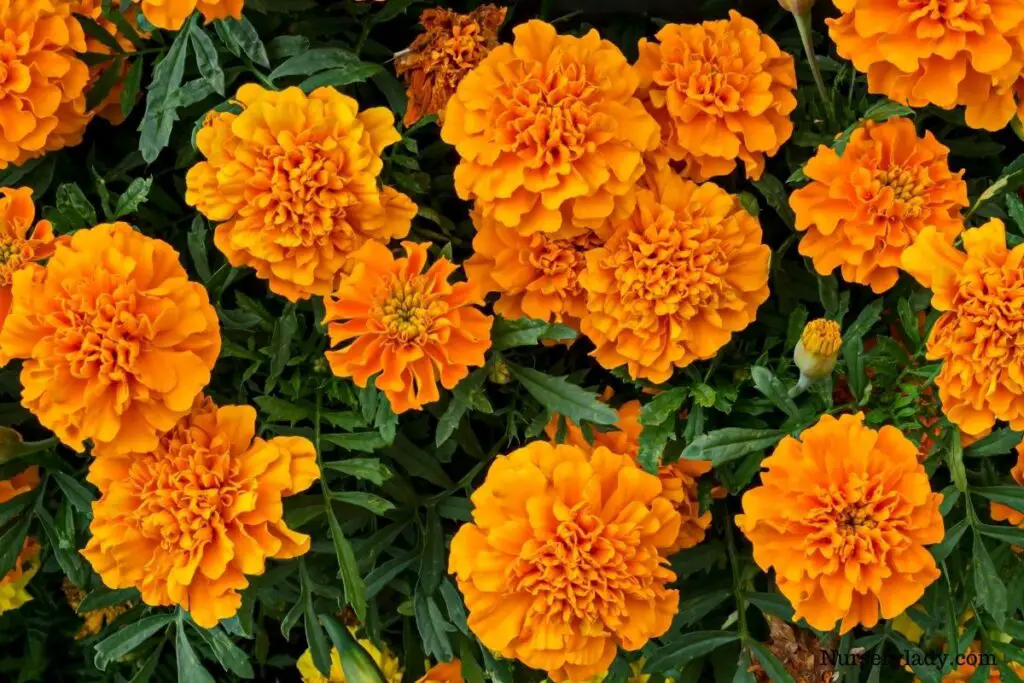
Marigolds are popular plants that are easy to grow and will brighten your garden with their bright flowers from early summer till frost. Their flowers are round in hues of yellow and orange with fern-like foliage. They usually have an odor that repels insects, making them perfect for vegetable gardens. They are heat-loving plants, making them a good choice for gardeners in n Southern California.
Sunlight: Marigolds are sun-loving plants and will have the best flowers in full sun. It will grow in partial shade, too but might have lesser blooms. Moreover, the plant may become leggy and droop over.
Watering: Marigolds appreciate regular watering, especially during summer—water with one cup of water for even watering and to prevent over-watering. If you overwater them, they get prone to root rot, fungal diseases, etc. It is okay to keep the plant underwater rather than over-watered.
Fertilizer: Marigolds are not easy-going plants without any reason. They can grow without any feeding. If you wish to feed them, use slow-release fertilizer while planting them or use diluted balanced fertilizer during their growing duration. Always follow instructions for the amount to be applied.
General care: Marigolds bloom best in high temperatures, slaying in hot, dry conditions like a pro. They cannot survive in temperatures below 40°F and will die in such situations. In cold, damp weather, the plant gets damaged due to fungal disease, root rot, etc. Trimming their tips is good as marigolds become top-heavy and also to promote branching.
Azaleas
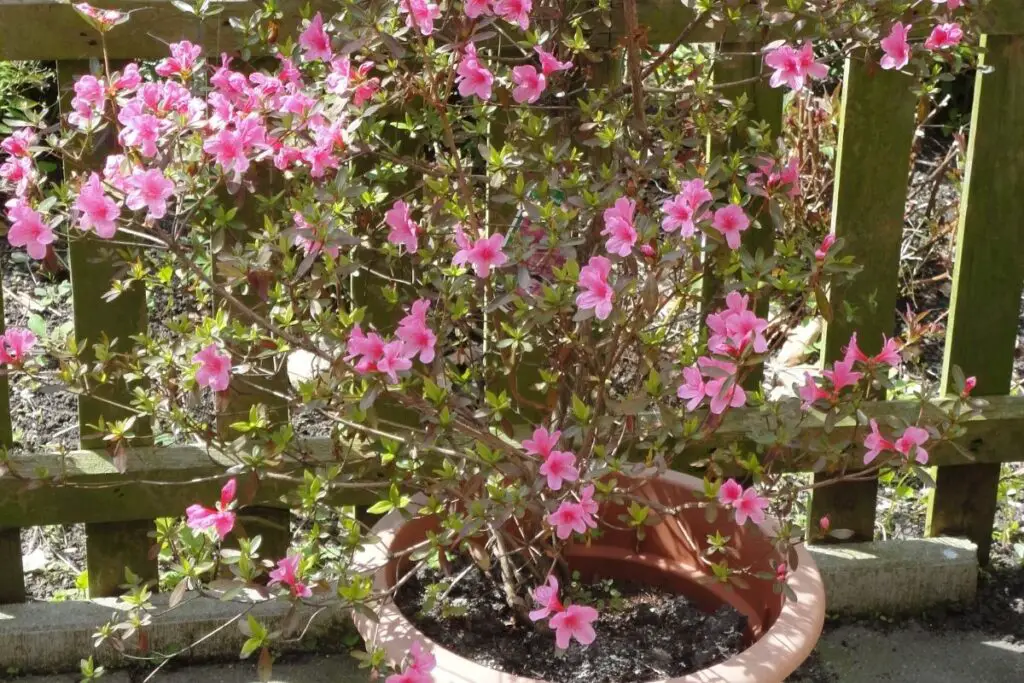
Azaleas feature thick evergreen leaves, looking best in containers. Most of their species grow slowly. They are advised to void children and animals since they are toxic. They are pretty particular about their environmental needs and will be easy-going in such conditions.
Sunlight: Azaleas like partial shade, and some direct light along with it completes the light dose. Some morning light is good as it helps in keeping the flowers upright. During winter, they appreciate the full sun as much as possible.
Watering: Azaleas like to be watered and bloom only with proper watering. Rain showers will be enough during rainy days to fulfill their water needs.
Fertilizer: Azaleas are light feeders and need food for a nutrient boost. Feed them with a balanced fertilizer by diluting them to half the recommended strength. There are fertilizers specially formulated for azaleas, such as azalea-tone, which also you can use.
General care: Azaleas prefer warm temperatures. Extreme colds may not form buds, and in hot temperatures may get sunburn. Good airflow is crucial for healthy and disease-free plants. Prune them once the flowers drop in late spring to promote fuller growth.
Sea lavender
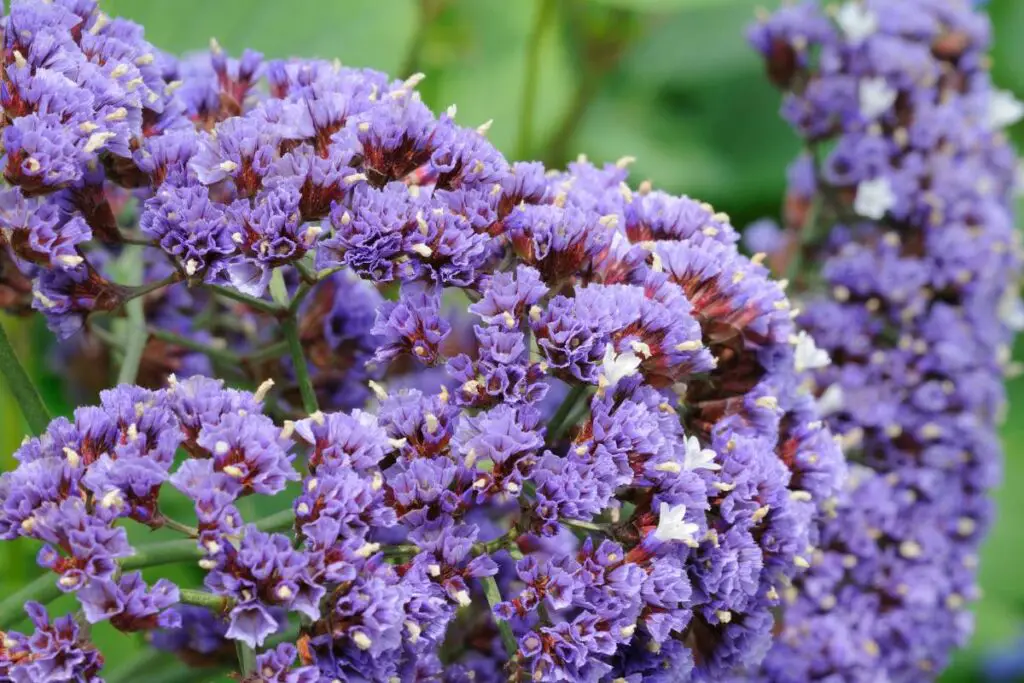
Sea lavender is not related to lavender plants. It has fragile flowers with leathery leaves. It looks incredible as ground cover due to its dense cloud-like flowers and rosette leaves in the early spring. Its eye-catching look makes it a perfect stand-alone plant or for a birding edge.
Sunlight: Sea lavender likes total sun exposure. The full sun supports the dense flower growth of the plant.
Watering: Water sea lavender regularly when they are young to establish strong roots. Matured, water the plant when the soil feels dry to the touch. It becomes drought-tolerant when established.
Fertilizer: Feed sea lavender only once during the growing season. Use a fertilizer high in nitrogen to promote flowering. Feeding too much can lead to excess foliage growth and little to no flowering and can even kill the plants.
General care: Sea lavender prefers a warm climate and blooms throughout the summer. It can tolerate windy conditions too. It does not demand much pruning; simply cutting it after flowering is enough.
Kangaroo paw
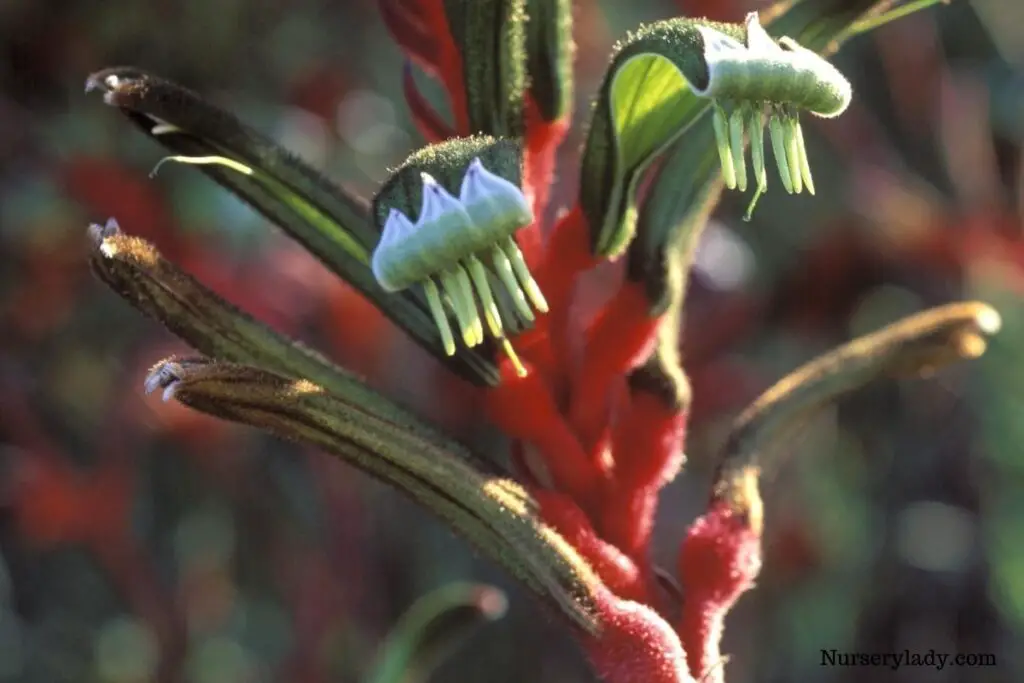
Kangaroo paws feature long, skinny foliage with tubular blooms appearing like an animal’s paw. It comes in multiple colors like orange, red, yellow, purple, etc. it’s a low-maintenance and fast-growing plant. It cannot survive winters; hence, it is treated as annual in areas with winter.
Sunlight: Kangaroo paw enjoys full sun, i.e., at least 6 hours daily. It can even withstand the hot summers of Southern California. Low light may reduce flower production and lead to dull plants.
Watering: Kangaroo paw grows best in evenly moist soil. It can tolerate drought to some extent. Too much watering can result in root rot and fungal diseases and even kill the plant. Let the soil dry halfway from the top before you water the plant.
Fertilizer: Kangaroo paw does not demand much feeding and can thrive without feeding. The best time to feed the plant is before the flower stalks appear. Apply a well-balanced fertilizer or a cup of compost to the soil for healthy growth and flowering.
General care: Kangaroo paw prefers high temperatures and avoids frost. Ideal temperatures for it are between 70°F to 80°F. It prefers arid conditions but can withstand humidity too. After flowering, cut the plant to 6 inches above the soil to promote denser growth.
Beer’s breeches
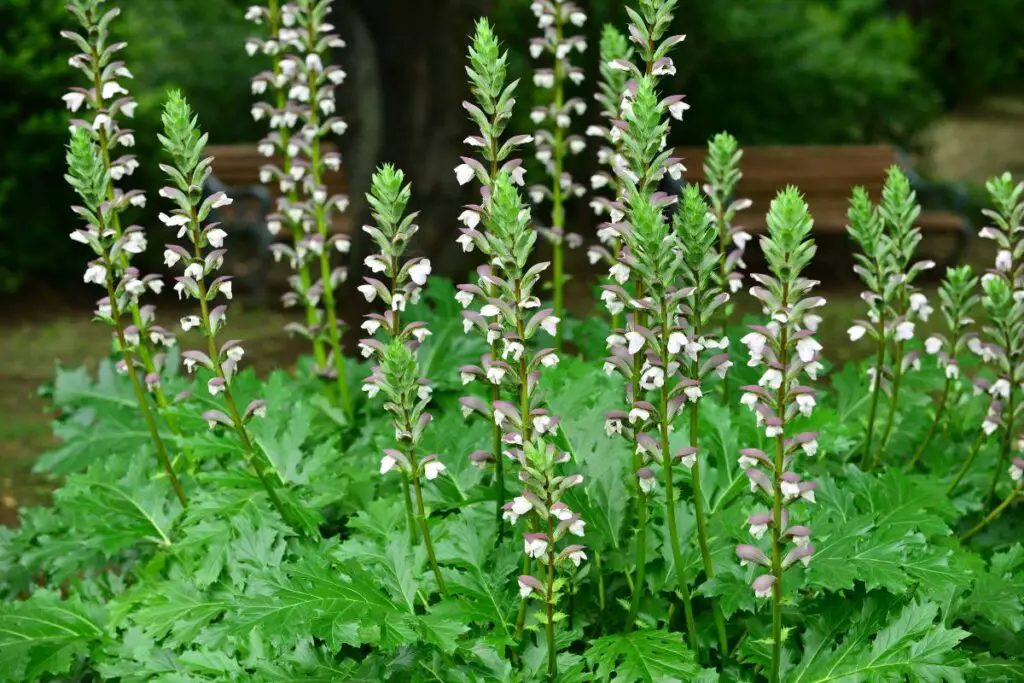
Beer’s breeches(Acanthus) are tall plants with glossy foliage and eye-catching flowers. They are also grown for their shiny foliage. They flower from late spring to mid-summer. They are so invasive that they need 3-4 feet to spread out. It is recommended to plant them near borders or in bottomless containers to control their growth.
Sunlight: Beer’s breeches do best in direct sun to partial shade. However, they ask for some protection in the hot summer. They need full sunshine to bloom well.
Watering: Beer’s breeches like regular watering when young. Established plants become drought tolerant, and weekly watering is enough.
Fertilizer: Beer’s breeches are light feeders. They will flourish in rich soil and a side dressing of compost once a year. If the plant looks dull, use a balanced fertilizer once in spring or summer.
General care: Beer’s breeches need some protection in winter. A thick layer of mulch during winter will protect the plant. Cut back the plants after flowering to encourage new growth.
Bird of paradise
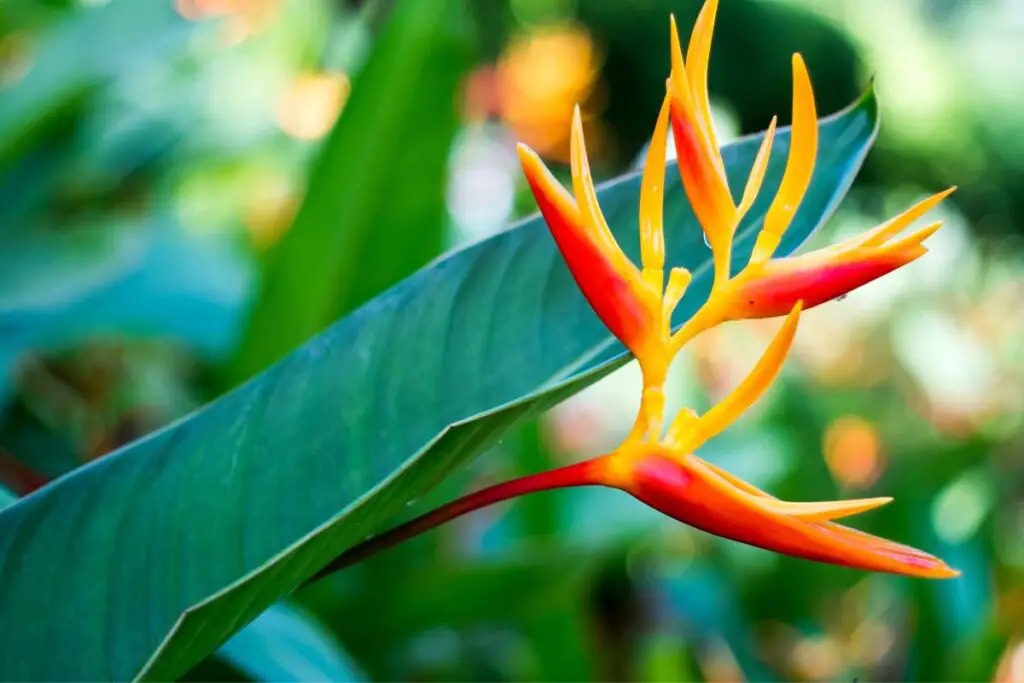
Bird of paradise is a popular tropical plant resembling a bird with the same name. With an easy-growing attitude, it also grows fast. It usually flowers in late winter or early spring but can flower at other times if the conditions are favorable. They have 12 to 18 inches large leaves and grow 5 to 6 feet tall.
Sunlight: Bird of paradise grows successfully in direct and bright light. However, some shielding is appreciated in hot afternoon summers. East-to-west-facing windows are ideal for these plants.
Watering: Water the bird of paradise regularly to keep the soil evenly moist. It requires regular watering in summer as it loses its moisture through its foliage. This doesn’t mean you can keep it waterlogged, as it can develop crisp brown leaves.
Fertilizer: The bird of paradise demands feeding for the best growth and flowering. A slow-release fertilizer in the spring or liquid fertilizer weekly in the growing season keeps the plant healthy and growing.
General care: Bird of paradise likes high humidity; misting regularly during dry weather is essential. It prefers temperature levels above 60°F. During cold temperatures, protect the plant as it may suffer from cold damage.
